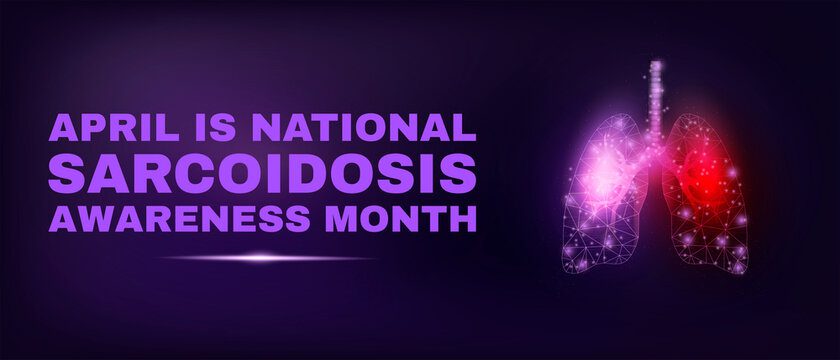Search by Color or Cause


National Sarcoidosis Awareness Month is observed in April, and calls attention to sarcoidosis. It also encourages further research into this rare condition. In 2008, Congress declared April as National Sarcoidosis Awareness Month. This brings more attention to this rare and complicated disorder. The awareness color ribbon associated with sarcoidosis is purple.
National Sarcoidosis Awareness Month educates that sarcoidosis is an inflammatory disease. As a result, the immune system goes into overdrive. This causes cells to group together into clumps called granulomas. While more than 90 percent of cases affect the lungs and lymph nodes, sarcoidosis also can cause skin and eye damage. Occasionally, those with sarcoidosis develop granulomas and inflammation in the heart. As a result, this can trigger abnormal heart rhythms and heart failure. This condition is known as cardiac sarcoidosis.
Today, it is estimated that 175,000 people in the U.S. have sarcoidosis. Further, an estimated 1.2 million individuals are living with the disease worldwide. Despite increasing advances in research, sarcoidosis remains difficult to diagnose with limited treatment options and no known cure. Many people with sarcoidosis don’t realize they have the illness. The disorder often has no signs or symptoms, or only mild ones.
Sarcoidosis is a chronic (long-term) disorder that causes inflammation and lumps called granulomas in the body’s organs. In addition, the lungs are usually involved, although the condition affects any organ. This includes the skin, eyes, liver, and brain. Some people with sarcoidosis feel tired or depressed. They may wheeze, cough, or feel short of breath. The illness may also cause lumps, ulcers (sores), or areas of discolored skin.
Sarcoidosis affects people of all ages and races, but it’s most common among African Americans and people of Northern European descent. The cause is unknown, but genes and the immune system likely play a role. Treatment depends on symptoms and which organs are affected. In 2008, Congress declared April as National Sarcoidosis Awareness Month to bring more attention to this rare and complicated disorder.
Most people who have sarcoidosis have no signs or symptoms of the disease. In these cases, it is diagnosed when a chest x-ray is done for another reason, and it is found to be abnormal. Because sarcoidosis so often affects the lungs, the most common symptoms of sarcoidosis include shortness of breath and chronic cough. Because sarcoidosis can affect the entire body, a wide variety of symptoms accompany sarcoidosis. Other symptoms of sarcoidosis include:
Sarcoidosis manifests differently in different groups of people. While the lungs and lymph nodes are affected in almost everyone who has sarcoidosis, African-Americans and people of Japanese descent are more likely to have eye involvement than Caucasians. Skin lumps are most likely to affect people of Northern European descent, and those with a Japanese background.
No one knows exactly what causes sarcoidosis. The fact that someone is more likely to develop the disease if someone in his or her close family has sarcoidosis suggests that genetics plays a role. Researchers haven’t yet found a gene or genes linked to the development of sarcoidosis. However, they continue to look.
Some research suggests that, for instance, bacteria, viruses, or chemicals might trigger the disease. Such triggers, although usually harmless in most people, might irritate the immune systems of people who are at genetic risk for developing sarcoidosis. Puerto Ricans and people of Japanese descent are more like to have eye involvement than Caucasians. In addition, skin lumps are most likely to affect people of Northern European descent. However, those with a Japanese background seem prone to sarcoidosis-related heart problems.
Sarcoidosis can cause serious health problems. It’s important to remember, though, that most cases of sarcoidosis are not severe and do not cause lasting damage to the body.
Sarcoidosis of the lungs can lead to the development of scar tissue in the lungs. This condition is called pulmonary fibrosis. As a result, pulmonary fibrosis can make it difficult for the lungs to effectively take in air and oxygen. Severe pulmonary fibrosis can lead to respiratory failure and death.
Other sarcoidosis-related lung complications include pulmonary hypertension (high blood pressure in the major arteries leading to the lungs) and mucus buildup in the airways (which makes it difficult to breathe and increases the likelihood of developing lung infections).
Sarcoidosis that affects the eyes can cause inflammation that may lead to glaucoma, cataracts, or blindness. These complications are usually avoided with good medical care and treatment.
Sarcoidosis sometimes affects the heart and can cause irregular heartbeat, heart failure, and heart attacks. Because these problems can lead to severe complications, screening for cardiac (heart) sarcoidosis is important for everyone with sarcoidosis. Appropriate treatment can help avoid these complications.
Other complications of sarcoidosis include, for example:
Remember, though, that MOST people with sarcoidosis do not experience any serious complications.